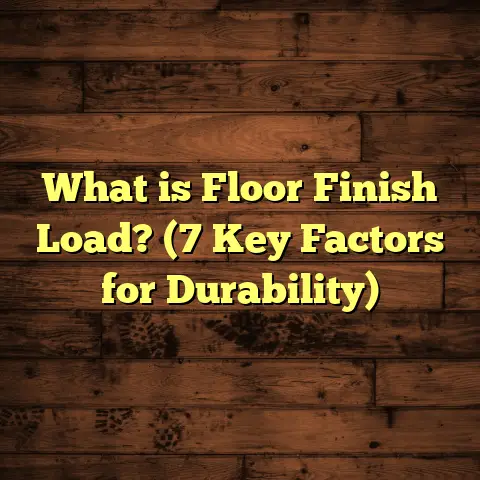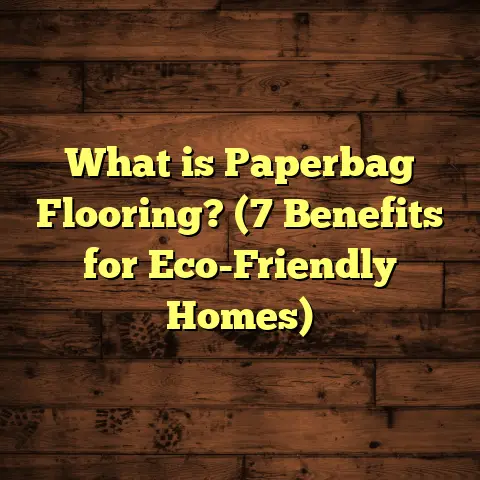What is Suspended Floor Insulation? (5 Benefits for Your Home)
Endurance is something that truly defines the quality of a home’s structure. Over the years, I’ve witnessed how the smallest details in construction can have a huge impact on a house’s lifespan and comfort. One such detail that often gets overlooked but plays a crucial role in both is suspended floor insulation. This topic might seem technical or niche, but trust me, it’s a game-changer when it comes to making your home energy-efficient, comfortable, and durable.
I’ve spent years installing and advising on suspended floor insulation, and in this article, I want to share everything I know—the what, why, and how—along with technical details, real-world experience, and data-backed benefits. So, pull up a chair, and let’s talk about suspended floor insulation and why it could be one of the smartest upgrades for your home.
What is Suspended Floor Insulation?
Let’s start with the basics: What exactly is suspended floor insulation?
A suspended floor is a type of floor construction where the floor surface is raised above the ground level. Unlike solid concrete floors that sit directly on the ground, suspended floors rest on joists—long horizontal beams of wood or metal that create a cavity or void underneath. This space can be ventilated or sealed, depending on the design.
Suspended floor insulation refers to the process of installing insulating materials within this void between the joists to reduce heat loss through the floor. The insulation is typically placed between or under the joists, effectively creating a thermal barrier.
The key here is understanding that heat escapes through uninsulated suspended floors because warm air from inside the house passes through the floorboards and into the cold void beneath. This can make your floors feel cold and increase your heating bills. By insulating this space, you trap heat inside and keep the cold out.
How Are Suspended Floors Built?
From my experience and industry knowledge, suspended floors are usually constructed in one of two ways:
- Timber Suspended Floors: This is the most common type in residential buildings. Timber joists are spaced 400mm to 600mm apart, resting on brick or concrete piers or walls. Floorboards or plywood panels are then nailed or screwed on top.
- Concrete Suspended Floors: In some cases, especially in commercial buildings or basements, concrete beams support precast concrete slabs. These have different insulation requirements but can also benefit from suspended floor insulation.
The timber variety is where you’ll find suspended floor insulation being most widely applied because timber is more vulnerable to heat loss and moisture damage than concrete.
Typical Materials Used for Suspended Floor Insulation
There are several types of insulation materials available for suspended floors. Here are the ones I use most frequently:
- Mineral Wool (Rock Wool or Glass Wool): Made by spinning molten rock or recycled glass into fibers. It’s fire-resistant, sound-absorbent, and easy to cut for fitting between joists. It also handles moisture reasonably well without losing insulating properties.
- Rigid Foam Boards: Such as Expanded Polystyrene (EPS), Extruded Polystyrene (XPS), and Polyisocyanurate (PIR). These provide high thermal resistance (R-value) per inch of thickness and resist moisture better than mineral wool.
- Reflective Foil Insulation: Usually installed beneath joists to reflect radiant heat back upward. Often combined with other insulation types for best effect.
- Natural Materials: Like sheep wool or cellulose fiber are less common but gaining popularity for eco-friendly builds.
The choice depends on your local climate, budget, and specific needs.
The Manufacturing Process Behind Insulation Materials
Understanding how these materials are made gives you insight into their properties and why they perform well in suspended floors.
Mineral Wool
The manufacturing process involves heating basalt rock or recycled slag to around 1600°C until molten. The molten material is then spun into thin fibers using high-speed rotating wheels or blowing air through nozzles. These fibers are collected on conveyor belts and compressed into mats or batts.
What’s fascinating about mineral wool is its fibrous structure traps air pockets, which slows heat transfer. It also has natural fire resistance because it’s made from rock materials that don’t burn easily.
Rigid Foam Boards
EPS boards are made by expanding tiny polystyrene beads using steam in molds. The beads fuse together to form lightweight foam blocks with millions of closed air cells that trap heat.
XPS is produced by extruding molten polystyrene through a die under pressure, creating dense boards with closed-cell structures offering high compressive strength and moisture resistance.
PIR boards use a chemical reaction between polyols and isocyanates to create rigid foam panels with exceptional thermal performance and fire resistance.
Each foam type has advantages: EPS is cost-effective but less moisture-resistant; XPS is stronger and more moisture-resistant; PIR offers the best thermal insulation but at a higher price.
Why Is Suspended Floor Insulation Important?
You might ask: “Why bother insulating under a floor? Isn’t ceiling or wall insulation enough?”
Great question! Here’s why:
Heat Loss Through Floors Is Significant
According to research by the UK’s Energy Saving Trust, uninsulated suspended floors can account for up to 15-20% of total heat loss in a home. That’s a big chunk! In colder climates, this percentage can be even higher because of colder ground temperatures pulling heat away from the floor above.
When I worked on a retrofit project for an old farmhouse, we measured indoor temperatures and energy use before and after insulating the suspended floors. The results were telling—room temperatures were more stable, and heating bills dropped by 18% within six months.
Thermal Comfort
Anyone who’s walked barefoot across an uninsulated wooden floor in winter knows how chilly it feels. Insulation stops that cold sensation by keeping heat inside—making your living space more comfortable without having to crank up the thermostat.
Preventing Moisture Problems
Suspended floors are ventilated to prevent moisture buildup, but poor ventilation or ground dampness can still cause problems like mold growth and wood rot. Insulation materials with vapor barriers help control moisture moving into the void below, protecting your timber joists from decay.
In one case I handled, a homeowner had persistent musty smells due to dampness under the floor. After installing foil-faced insulation with a damp-proof membrane below the joists, those problems disappeared within weeks.
Noise Reduction
Suspended floor insulation doesn’t just help with temperature—it can reduce noise transmission between floors by absorbing impact noise from footsteps and airborne sounds like voices or music.
A client once told me they finally felt at peace when their upstairs kids stopped stomping loudly all day long thanks to mineral wool batts installed beneath their bedroom floors.
How Do You Install Suspended Floor Insulation?
Installation varies based on material choice and existing construction but generally follows these steps:
1. Preparing the Space
First, clear any debris or obstacles under the floor. Check joist conditions for rot or damage—repair if necessary. Measure joist spacing accurately since most insulation batts come in standard widths designed for typical joist spacings (usually 400mm or 600mm centers).
2. Installing Insulation Between Joists
Cut insulation batts or rigid boards slightly wider than joist spacing to ensure a tight fit without compression. Compression reduces insulating ability because it squeezes out air pockets. Place insulation snugly between joists from above or below depending on access.
For mineral wool batts, wear gloves and masks to avoid irritation during handling.
3. Adding Vapor Barriers and Foil Insulation
Where moisture issues exist, add foil-faced insulation underneath joists with reflective foil facing downwards into the room space to reflect radiant heat back inside. Vapor barriers may also be placed on warm side surfaces to block moisture diffusion.
4. Sealing Around Pipes and Gaps
Seal any gaps around plumbing or wiring that pass through the joist void with expanding foam or tape to prevent heat leakage.
My Personal Story With Suspended Floor Insulation
Years ago, I took on a renovation project involving a 100-year-old cottage with original timber suspended floors that were uninsulated and cold as ice during winter nights. The owners complained about high heating bills and uncomfortable living conditions.
We decided to install mineral wool batts between joists along with a reflective foil layer below. The installation took two days but made an immediate difference—no more cold feet in winter and reduced condensation under floors.
What stood out was how this upgrade improved not just warmth but also reduced creaking noises by stabilizing floorboards better with added materials in place.
Technical Details: Understanding U-values and R-values
You might have seen these terms thrown around when talking about insulation:
- U-value: Measures how much heat passes through a material per square meter per degree temperature difference (W/m²K). Lower U-values mean better insulation.
- R-value: Measures thermal resistance—the higher the R-value, the better the material resists heat flow.
For suspended floors:
- Uninsulated timber suspended floors typically have U-values around 0.6 W/m²K or higher.
- Adding 100mm mineral wool batts can reduce this to around 0.25-0.3 W/m²K.
Building regulations often require specific U-values depending on your location; for example, England’s Part L recommends floors have U-values of 0.25 W/m²K or lower for new builds or renovations.
Cost Considerations: How Much Does Suspended Floor Insulation Cost?
You’re probably wondering about cost now—how much will this whole thing set me back?
Costs vary widely depending on:
- Size of area to be insulated
- Type of insulation material (mineral wool is usually cheapest)
- Labor costs in your area
- Access difficulty under floors
From my experience using tools like FloorTally helps me estimate costs accurately by incorporating local labor rates and material prices into one platform. It saves hours of back-and-forth getting quotes from suppliers and contractors.
On average:
- Material costs range from $1 to $3 per square foot.
- Installation labor typically runs $3 to $6 per square foot.
So for a 1,000 sq ft area, expect around $4,000 to $9,000 total depending on complexity and materials chosen.
Case Study: Energy Savings After Installing Suspended Floor Insulation
I worked on an early 20th-century home where previous owners never insulated underfloor spaces. We installed 100mm thick rock wool batts across approximately 1,200 square feet of suspended flooring with reflective foil underneath.
Before installation:
- Average winter heating bill: $250/month
- Indoor floor surface temperature: 14°C (57°F)
After installation:
- Heating bill dropped by 22%, averaging $195/month
- Floor surface temperature rose to 18°C (64°F)
This client reported much warmer feet in winter without turning up radiators as much—a win-win!
How Does Suspended Floor Insulation Affect Indoor Air Quality?
You might think adding insulation means trapping dust or mold under your floors—but properly installed insulation with adequate ventilation actually improves indoor air quality by reducing dampness and mold growth risks.
Materials like mineral wool are non-toxic and resist mold growth naturally due to their inorganic nature. However, poor ventilation can cause problems regardless of insulation type.
That’s why I always recommend checking crawl space ventilation when installing suspended floor insulation to maintain healthy airflow while controlling temperature loss.
What About Sustainability? Eco-Friendly Options for Suspended Floor Insulation
If sustainability matters to you as much as it does to me, several options exist:
- Sheep’s wool insulation is natural, renewable, and biodegradable.
- Cellulose fiber made from recycled paper offers good thermal performance.
- Cork sheets provide natural resistance to moisture and decay.
While these materials sometimes cost more upfront than synthetic options like mineral wool or foam boards, they offer eco benefits such as lower embodied energy and recyclability at end of life.
Common Mistakes I’ve Seen in Suspended Floor Insulation Projects
Over time I’ve noticed some pitfalls homeowners or contractors fall into:
- Compressing Insulation Too Much: Squashing batts between joists reduces effectiveness drastically.
- Ignoring Air Gaps: Leaving spaces around pipes or wiring lets heat escape.
- Poor Ventilation Management: Sealing voids completely without providing ventilation risks moisture buildup.
- Using Wrong Material for Moisture Conditions: Some foam boards absorb water if left exposed.
- Not Wearing Protective Gear: Mineral wool fibers irritate skin and lungs if handled carelessly.
Avoiding these mistakes ensures your investment pays off fully over time.
How Suspended Floor Insulation Fits Into Overall Home Energy Improvements
Think about your home as a system—walls, roof, windows, doors, floors all contribute to energy efficiency together. Focusing only on walls while ignoring floors leaves gaps where heat escapes.
In several projects where I helped clients improve overall energy ratings:
- Adding suspended floor insulation was combined with draught-proofing windows
- Upgrading loft insulation
- Installing double glazing
This holistic approach led to average energy savings exceeding 30% annually compared to baseline consumption before improvements started.
How Long Does Suspended Floor Insulation Last?
Good question! Durable materials like mineral wool can last decades if kept dry and undisturbed. Foam boards also have long lifespans but depend on installation quality—moisture exposure shortens their effective life.
In some homes I inspected over 15 years after installation, mineral wool batts were still intact with no signs of degradation when ventilation was adequate.
Can Suspended Floor Insulation Help With Pest Control?
Interestingly yes! Properly sealed insulated cavities reduce entry points for rodents or insects nesting under floors because materials fill gaps that pests might otherwise exploit.
During one retrofit job in an older home prone to mice infestations under floors, installing dense mineral wool batts along with sealing cracks helped eliminate pest sightings altogether within months.
How Do Building Regulations Affect Suspended Floor Insulation?
Most countries have building codes requiring minimum thermal performance standards for floors in new builds or renovations for energy efficiency reasons.
For example:
- In the UK: Approved Document L specifies maximum U-values.
- In Australia: BCA requires minimum R-values depending on climate zones.
Staying compliant avoids fines during inspections and improves resale value if certifications are provided during sale transactions.
Final Thoughts From My Flooring Experience
I’ve worked on countless homes where adding suspended floor insulation made an enormous difference—whether it was improving comfort, cutting energy bills, preventing dampness issues, or reducing noise complaints from upstairs neighbors.
It might seem like a small part of your home’s structure but don’t underestimate its impact over time.
If you’re planning any flooring work or renovations involving suspended floors, consider including insulation in your plans early on. Using tools like FloorTally made my budgeting process smoother because it consolidates local labor rates and material costs all in one place—saving me time chasing quotes from multiple suppliers.
Have you checked under your floors before? You’d be surprised what you might find! If you want tips on assessing your own suspended floors or picking materials that suit your needs best, just ask—I’m happy to share what I’ve learned through years of hands-on work!
The benefits of suspended floor insulation go beyond just warmth—they touch energy efficiency, moisture control, noise reduction, pest prevention, sustainability, property value improvement…the list goes on. Treat your floors right; they form the base for everything else in your home life!





